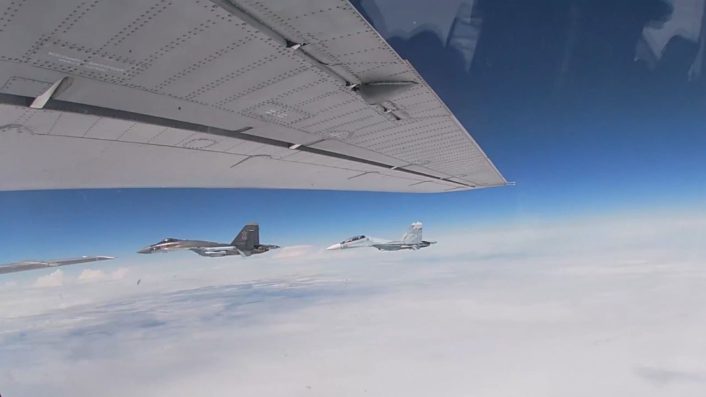On Jul. 30, the Japanese also reported a Chinese WZ-7 reconnaissance drone performing a provocative flight over the East China Sea.
Two Russian Tu-95MS strategic bombers conducted a 10-hour flight over the Sea of Japan on Jul. 31, 2024, accompanied by Su-35S and Su-30SM jets as escort fighters, according to the RuMoD (Russian Ministry of Defense). The Japan MoD however added that the Russian aircraft entered the ADIZ (Air Defense Identification Zone) three times, prompting the JASDF (Japan Air Self-Defense Force) to scramble its fighters in response.
The Japanese MoD later released a map marking the Russian flight routes, while the Russian Defense Ministry added that its planes were “accompanied by foreign fighters at certain stages of the route.” The RuMoD often releases footage of flights near NATO airspace in Europe, where Allied fighters are visible in recordings shot from inside the aircraft, however it was not the case this time.
Provocative 🇷🇺 air patrol yesterday above the Sea of Japan: 3 pairs of Tu-95 bombers, each accompanied by 2 fighters (+ 2 presumed aircraft), making U-turns near #Japan.
I don’t remember #Russia‘s planes taking such China-in-Taiwan Strait trajectories. pic.twitter.com/0sFkwpeyiC— Lionel Fatton (@LionelFatton) July 31, 2024
The crews of the Russian aircraft “carried out the flight in strict accordance with international rules for the use of neutral airspace,” said the statement from the Russians. “Long-range aviation pilots regularly fly over the neutral waters of the Arctic, North Atlantic, Pacific Ocean, as well as the Black and Baltic Seas.”
The day before, on Jul. 30, the Japanese also claimed two airspace violations and intrusions over the ECS (East China Sea), one of which was a Chinese WZ-7 Soaring Dragon reconnaissance drone. According to the map released by the Japanese MoD, the drone orbited for a while over the ECS before turning back.
令和6年7月30日(火)中国軍の偵察型無人機(WZ-7)1機が奄美大島北西沖海上まで飛行し反転、東シナ海上で旋回した後に大陸方面に北東進しました。#航空自衛隊 の西部航空方面隊等の戦闘機を #緊急発進 させ対応しました。#スクランブル pic.twitter.com/3kYLteEsFs
— 防衛省統合幕僚監部 (@jointstaffpa) July 30, 2024
This also comes within a week after two Tu-95s and two Chinese H-6K strategic bombers made a rare flight into Alaska’s ADIZ (Air Defense Identification Zone) on Jul. 24, during which they were intercepted by U.S. F-35s and F-16s and Canadian CF-188 jets. In general this represents the evolution of far northeast Asia and the Arctic as a major simmering flashpoint.

Three ADIZ “intrusions” in ten hours
According to a statement by the Japan MoD Joint Staff, the Russian flights took place from the morning to the afternoon of Tuesday, Jul. 30, 2024. “Two Russian Tu-95 bombers and two fighter jets flew from the continent, headed east over the Sea of Japan, then changed course off the coast of Oki Island, Shimane Prefecture, and headed north toward the continent,” said the MoD about the first intrusion.
After that, the four aircraft then “flew again from the continent, headed east from the west of Hokkaido toward Japan’s airspace, changed course north off the coast of Okushiri Island, Hokkaido, flew along the vicinity of Japan’s airspace, changed course off the coast of Kamui Cape, Hokkaido, and headed west toward the continent.” In the third flight into the ADIZ, the quartet headed southeast toward Japan’s airspace, changed course off the coast of Noto Peninsula, Ishikawa Prefecture, and headed northwest toward the continent.
Additionally, while operating off the coast of Hokkaido and Ishikawa Prefecture, it was confirmed that in addition to two fighter jets, “one presumably Russian aircraft was flying in the same airspace.” In response, fighter jets from the JASDF’s Central Air Defense Force and other forces were scrambled to the area.
Two Tu-95MS strategic missile carriers escorted by Su-30SM and Su-35S fighters performed a flight over the waters of the Sea of Japan. The flight lasted about 10 hours.
📹MoD RF (July 30)https://t.co/DHUZcKmsHrhttps://t.co/nRvCCFy21M pic.twitter.com/3uxhH2UGiw— Massimo Frantarelli (@MrFrantarelli) July 30, 2024
The Joint Staff posted on X: “JASDF’s fighters scrambled to cope with a suspected intrusion into Japan’s airspace over the East China Sea and the Sea of Japan. JSDF continues to responding to protect our territory and peace for the people of Japan 24/7.” While the type of aircraft sent up to intercept the Tu-95s was not known, JASDF has scrambled its F-15Js for such roles in the past. The post also carried a sample image of an F-15J, specifying it was unrelated to the latest interception.
The scrambles on July 30 and 31
On Jul. 30, the Joint Staff reported again the “possibility of an airspace violation in the ECS,” prompting fighter jets from the Southwest Air Defense Force at Naha Air Base to scramble. The post carried a sample representative image of an F-15J, indicating this was the fighter sent up to intercept the threat.
Around two hours later, the Joint Staff posted a map with the route of a flight which intruded the ADIZ, along with an image of the Chinese military reconnaissance drone WZ-7. The UAV flew over the sea to the northwest coast of the Amami Oshima, turned around, circled over the ECS and then headed northeast toward the mainland, according to the MoD.
Western Air Defense Force and other fighter jets were dispatched to respond. It is not immediately clear if these two ADIZ intrusion reports belong to the same flight by the WZ-7, with the subsequent report being an update of the previous one. On Jul. 31, a suspected intrusion was reported over the ECS and the Sea of Japan, with fighters scrambled once again, but no further details were released.
Previous Russian ADIZ flights into Japan
This is the third time this year that Russian Tu-95s have flown over the Sea of Japan, with the first instance reported on Jan. 17. At the time, two Tu-95s conducted a seven-hour patrol over the Sea of Japan, with a Su-35 and a Su-30 seen escorting them from the cockpit footage.
Then on Apr. 2, the RuMoD released another footage of Tu-95 strategic bombers “patrolling” over the Sea of Japan. A Su-30 is seen escorting the bomber at one point, but it is not clear if other fighters were also involved.

